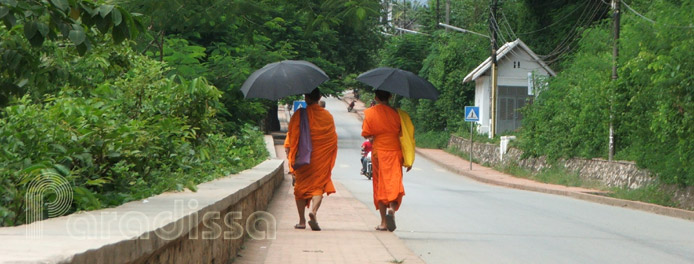Below are some helpful guides to Lao culture, traditions and culture traits which may be of use especially to the independent travelers.
Laos Society
Laos is a multi-ethnic society. Each ethnic group has their own language and culture; and the etiquette, behaviors, customs and social gestures vary from one group to another. The diversity of the culture among different ethnic groups may cause cultural difficulties to the independent travellers venturing through the country.
Basically Laos has more of rural areas than urban ones, except for the capital city of Vientiane which is a leisure-paced urban town. Most of Lao population inhabits in villages of which the members are tied together based mostly on kinship. Each village is relatively isolated from others due to poor infrastructure and each village has self-sufficient economy which is based mostly on wet rice or swidden farming. People of one village don't have much connection with another village and marriages among people of different villages are not common. For this reason, it can be said that Laos culture is preserved independently in the myriad villages throughout the country.
Laos has a tradition of respecting the elderly. In most villages, the oldest man has a very important role in influencing the decisions affecting the community. Besides, there may be a village chief who acts as intermediary between the community and the government.
Laos is an agricultural society and the staple food is rice. Glutinous rice is more popular than ordinary rice among the Laos Loum (Lowland Lao) and Lao Theung (Midland Lao), while ordinary rice is more common among many tribes of the Lao Sung (Upland Lao). Glutinous rice is steamed and not boiled. The Lao normally eat glutinous rice with the hands. And Lao festivals, school vacations and government ceremonies revolve around agricultural seasons. Agriculture influences much in the Laos culture.
Most ethnic groups in Laos are patrilineal and gender work differentiation is based mostly on the natural differences, not on discrimination. Marriages are normally the choice of the bride and groom and arranged marriages are not common. In many of the ethnic groups, after the wedding the groom must stay at the bride's family and works as payment for the bride.
Most ethnic groups in Laos believe in animism and believe in the existence of spirits of places and people. The Lowland Lao follows Theravada Buddhism while the others may also follow Christianity, Protestant or Catholicism. The Buddhist monks and ritual leader play an important role in the life of the village and they are well-respected by the community.
Laos is yet to have a very good educational or medicare system. Normally a boy may choose to study at a Buddhist wat for a period ranging from a few days to a few months. Social services don't exist in the country. Life expectancy is short and infant mortality is high in Laos.
Lao Customs and Traditions
The traditional form of greetings among the Lao people is the Nop, placing the palms together in a position of praying, at chest level with the elbow not touching the body. The higher the hand, the greater the sign of respect, although they should not be above the level of the nose. This should be accompanied by a slight bow to the persons of higher status or age. The Nop is not only an expression of greeting, but also of thanks, of apology or bidding farewell. It is accepted to shake hands with foreigners.
The head is considered the sacred part of the body and should not be touched by other people, except for close family members. The soles of the feet are the lowest part of the body, physically and spiritually and they should not point towards or touch another person. Men and women are not to show intimacy in public. It is forbidden for a woman to touch a Buddhist monk. When handing an object to another person of higher status or age, one should do it with 02 hands. A woman is not allow to hand something to a Buddhist monk directly, but has to place it in the table or in front of him.
It is customary to remove your shoes or sandals when entering a Buddhist temple or someone's home. In Lao, homes are raised off the ground, shoes or sandals are left at the stairs. In a traditional home, people sit on low seats or cushions on the floor. Men may sit with legs crossed in a lotus position or folded to one side while women sit with legs gracefully folded to the side. When visiting a family at their home, the guest is normally invited with something such as fruits, wine or tea. The guest is expected to take it; refusing the offer is considered rude.
Laos women are dressed properly in the daily life. Lao traditional costume for women is Phaa Nung which is sarong-like. The men are dressed with normal clothing in their daily life. It is not accepted to wear shorts, singlets, short skirts in public. When visiting sacred places like temples, wats...Poorly-clad visitors are not allowed.
When things go wrong with your tour or your travel itinerary, don't show anger since it is counter-productive and it makes everyone around loose face. A big smile always seems to make things better. The Lao people are easy-going and ease-oriented people, when checking into and out of hotels or at restaurants, not to hurry the staff as the culture they are born into is meant to be that way.












